Venison backstrap recipe is a culinary adventure that celebrates the rich, lean, and tender qualities of this prized cut of meat. Backstrap, a muscle from the deer’s loin, offers a unique flavor profile that is both delicate and robust, making it a popular choice for grilling, roasting, and pan-searing.
This guide delves into the art of preparing venison backstrap, from selecting the perfect cut to mastering various cooking techniques. We’ll explore flavor combinations, serving suggestions, and even provide tips for utilizing leftovers. Whether you’re a seasoned hunter or a curious home cook, this comprehensive guide will empower you to create unforgettable venison backstrap dishes.
Introduction to Venison Backstrap
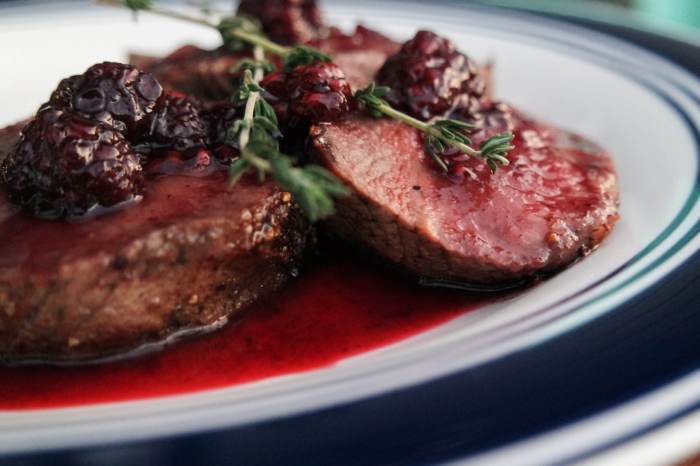
Venison backstrap, a cut of meat from the deer’s back, is prized for its tenderness and flavorful, lean profile. This cut is often considered the most tender and flavorful part of the deer, making it a favorite among hunters and chefs alike.Venison backstrap’s versatility makes it an excellent choice for a variety of cooking methods.
Its lean nature lends itself well to grilling, roasting, and pan-searing, resulting in juicy and flavorful dishes. Its unique flavor, which is often described as gamey, can be enhanced with various marinades, rubs, and sauces.
Nutritional Benefits of Venison
Venison is a lean source of protein, containing minimal fat and calories. It is also rich in essential nutrients, including iron, zinc, and B vitamins. Compared to other red meats, venison offers a healthier alternative due to its lower fat content and higher protein content.
Selecting and Preparing Venison Backstrap
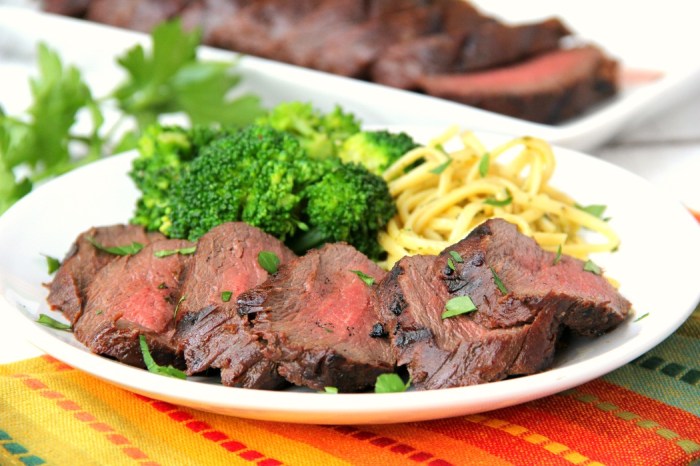
Venison backstrap, a prized cut from the deer’s back, is known for its tender texture and rich flavor. Understanding how to select and prepare this cut is crucial to creating delicious and satisfying meals.
Selecting High-Quality Venison Backstrap
When selecting venison backstrap, look for cuts that are firm to the touch and have a deep red color. The marbling, or presence of intramuscular fat, is a good indicator of flavor and tenderness. Venison with good marbling will have a more evenly distributed fat throughout the meat, resulting in a juicier and more flavorful final product.
Trimming Venison Backstrap
Before cooking, it’s important to trim any excess fat and silver skin from the venison backstrap. Excess fat can render during cooking, making the meat greasy, while silver skin is a tough membrane that can make the meat chewy.To trim the venison backstrap, use a sharp knife and follow these steps:
- Lay the venison backstrap flat on a cutting board.
- Identify any visible fat or silver skin. Fat will appear as white or yellow deposits, while silver skin is a thin, translucent membrane.
- Use the tip of your knife to carefully slice away the fat and silver skin, working in a smooth and consistent motion.
- Once all excess fat and silver skin have been removed, rinse the venison backstrap under cold water and pat dry with paper towels.
Venison Backstrap Recipes
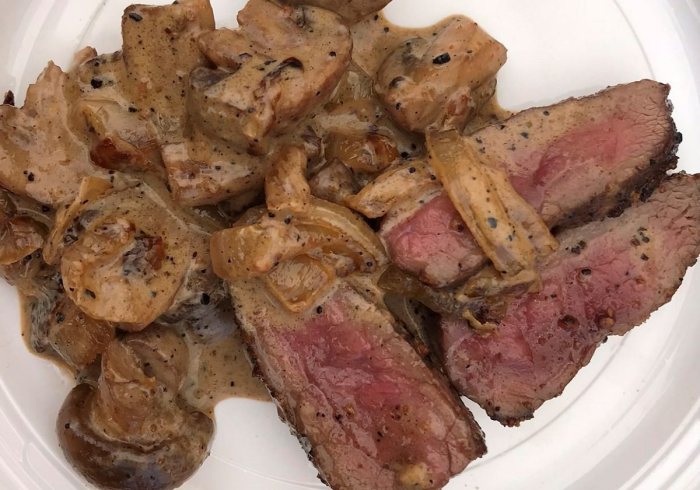
Venison backstrap, a lean and flavorful cut of meat, offers a versatile canvas for culinary creativity. Whether you prefer classic preparations or innovative twists, there’s a venison backstrap recipe for every taste. This section explores a range of recipes, categorized by cooking methods and flavor profiles, to inspire your next venison culinary adventure.
Grilled Venison Backstrap Recipes
Grilled venison backstrap recipes are a popular choice for their smoky flavor and tender texture. Grilling allows for quick cooking, resulting in a juicy and flavorful dish. Here are some popular options:
- Grilled Venison Backstrap with Rosemary and Garlic: This recipe features a simple marinade of rosemary, garlic, and olive oil, resulting in a flavorful and aromatic dish.
- Grilled Venison Backstrap with Blackberry Glaze: This recipe pairs the savory venison with a sweet and tangy blackberry glaze, creating a balance of flavors.
- Grilled Venison Backstrap with Chipotle Rub: For a bolder flavor, try a chipotle rub that adds a smoky and spicy kick to the venison.
Roasted Venison Backstrap Recipes
Roasted venison backstrap recipes offer a more traditional approach, resulting in a tender and flavorful dish. Roasting allows for even cooking and creates a crispy exterior. Here are some popular options:
- Roasted Venison Backstrap with Red Wine Sauce: This classic recipe pairs the venison with a rich and flavorful red wine sauce.
- Roasted Venison Backstrap with Wild Mushrooms: This recipe features a combination of wild mushrooms and herbs, adding an earthy and aromatic flavor to the venison.
- Roasted Venison Backstrap with Cranberry Sauce: This recipe combines the savory venison with a sweet and tart cranberry sauce, creating a classic holiday dish.
Pan-Seared Venison Backstrap Recipes
Pan-searing venison backstrap recipes are a quick and easy option for a flavorful meal. Pan-searing creates a crispy exterior while retaining the tenderness of the meat. Here are some popular options:
- Pan-Seared Venison Backstrap with Dijon Mustard Sauce: This recipe features a tangy and flavorful Dijon mustard sauce that complements the venison perfectly.
- Pan-Seared Venison Backstrap with Balsamic Glaze: This recipe uses a sweet and tangy balsamic glaze to create a delicious and visually appealing dish.
- Pan-Seared Venison Backstrap with Blue Cheese Butter: This recipe features a rich and creamy blue cheese butter that adds a decadent touch to the venison.
Slow-Cooked Venison Backstrap Recipes
Slow-cooked venison backstrap recipes are perfect for creating a tender and flavorful dish. Slow cooking allows the venison to break down, resulting in a melt-in-your-mouth texture. Here are some popular options:
- Slow-Cooked Venison Backstrap with Root Vegetables: This recipe features a combination of root vegetables, such as carrots, potatoes, and onions, that add sweetness and depth to the venison.
- Slow-Cooked Venison Backstrap with Red Wine and Herbs: This recipe uses red wine and fresh herbs to create a flavorful and aromatic dish.
- Slow-Cooked Venison Backstrap with Apricots and Almonds: This recipe features a combination of sweet apricots and crunchy almonds, adding a unique twist to the venison.
Cooking Techniques and Tips: Venison Backstrap Recipe
Venison backstrap is a lean and flavorful cut of meat that can be cooked using a variety of methods. The best cooking method for you will depend on your personal preferences and the desired level of doneness. Here are some popular techniques and tips for achieving the perfect venison backstrap:
Grilling
Grilling is a great way to cook venison backstrap because it imparts a delicious smoky flavor. The high heat of the grill sears the outside of the meat, creating a flavorful crust while keeping the inside juicy and tender.
- Before grilling, season the venison backstrap with salt, pepper, and any other desired spices.
- Preheat your grill to medium-high heat.
- Place the venison backstrap on the grill and cook for 4-6 minutes per side, or until it reaches an internal temperature of 135°F for medium-rare.
- Remove the venison from the grill and let it rest for 5-10 minutes before slicing and serving.
Pan-Searing
Pan-searing is a quick and easy way to cook venison backstrap. This technique involves searing the meat in a hot pan until it develops a crispy crust, then finishing it in the oven.
- Season the venison backstrap with salt, pepper, and any other desired spices.
- Heat a heavy-bottomed skillet over medium-high heat.
- Add a tablespoon of oil to the skillet and heat until shimmering.
- Place the venison backstrap in the skillet and sear for 2-3 minutes per side, or until it develops a nice crust.
- Transfer the skillet to a preheated oven at 350°F and bake for 10-15 minutes, or until the internal temperature reaches 135°F for medium-rare.
- Remove the venison from the oven and let it rest for 5-10 minutes before slicing and serving.
Slow Cooking
Slow cooking is a great way to tenderize venison backstrap and enhance its flavor. This method involves cooking the meat at a low temperature for an extended period of time, resulting in a succulent and flavorful dish.
- Season the venison backstrap with salt, pepper, and any other desired spices.
- Place the venison backstrap in a slow cooker and add your favorite vegetables, such as onions, carrots, and celery.
- Pour in enough liquid to cover the venison, such as broth or wine.
- Cook on low heat for 6-8 hours, or until the venison is fork-tender.
- Remove the venison from the slow cooker and shred it with two forks.
- Serve the shredded venison with the cooking liquid as a sauce.
Roasting
Roasting is a classic way to cook venison backstrap. This method involves cooking the meat in a preheated oven, allowing for even cooking and a flavorful result.
- Season the venison backstrap with salt, pepper, and any other desired spices.
- Place the venison backstrap in a roasting pan and roast in a preheated oven at 350°F for 15-20 minutes, or until the internal temperature reaches 135°F for medium-rare.
- Remove the venison from the oven and let it rest for 5-10 minutes before slicing and serving.
Tips for Achieving Optimal Doneness
- Use a meat thermometer to ensure accurate internal temperature.
- Allow the venison to rest for 5-10 minutes before slicing to allow the juices to redistribute.
- Overcooking venison can make it tough and dry.
- Venison is best served medium-rare to medium, with an internal temperature of 135°F to 145°F.
Tips for Maximizing Flavor
- Marinate the venison for several hours or overnight to enhance its flavor.
- Use a flavorful marinade, such as a mixture of soy sauce, honey, and garlic.
- Add herbs and spices to the venison while cooking.
- Serve the venison with a flavorful sauce, such as a red wine sauce or a mushroom sauce.
Flavor Combinations and Pairings
Venison backstrap’s lean, slightly gamey flavor lends itself to a wide range of culinary creations. The key is to balance the inherent richness with complementary flavors that enhance, rather than overwhelm, its natural taste.
Herbs and Spices
A selection of herbs and spices can elevate the venison backstrap’s flavor profile.
- Rosemary, thyme, and sage: These classic herbs provide a robust, earthy flavor that complements the venison’s gamey notes.
- Juniper berries: Adding a touch of juniper berries imparts a unique, slightly piney flavor that pairs well with venison’s earthy character.
- Garlic and onion: These aromatics add a savory depth that complements the venison’s richness.
- Black pepper and cayenne pepper: Black pepper provides a touch of heat, while cayenne pepper adds a subtle kick.
- Mustard seeds: Mustard seeds offer a sharp, tangy flavor that cuts through the richness of the venison.
Marinades
Marinades infuse the venison with flavor and tenderize the meat.
- Red wine marinade: A red wine marinade, incorporating herbs like rosemary and thyme, adds depth and complexity to the venison’s flavor.
- Citrus marinade: A marinade based on citrus juices, such as orange or lemon, brightens the venison’s flavor profile with a refreshing acidity.
- Soy-ginger marinade: This marinade, combining soy sauce and ginger, provides a savory, umami-rich flavor that complements the venison’s richness.
Sauces
Sauces can add a finishing touch to venison backstrap dishes.
- Red wine sauce: A rich red wine sauce, often incorporating shallots, mushrooms, and herbs, enhances the venison’s gamey flavor with a complex, savory depth.
- Cranberry sauce: The sweetness of cranberry sauce provides a delightful contrast to the venison’s savory notes, creating a balanced and festive flavor combination.
- Mushroom sauce: A creamy mushroom sauce, made with earthy porcini mushrooms, adds a luxurious and savory element to the venison.
Side Dishes
Side dishes that complement venison backstrap meals should offer a balance of textures and flavors.
- Roasted root vegetables: Roasted root vegetables, such as carrots, parsnips, and potatoes, provide a sweet and earthy counterpoint to the venison’s gamey flavor.
- Wild rice pilaf: The nutty flavor of wild rice pairs well with venison, offering a textural contrast and a satisfyingly hearty accompaniment.
- Green beans amandine: The crispness of green beans and the nutty flavor of almonds create a delightful textural and flavor combination.
Beverages
- Red wine: A full-bodied red wine, such as Cabernet Sauvignon or Merlot, complements the venison’s richness and gamey notes.
- Beer: A dark beer, such as a stout or porter, offers a rich and complex flavor that pairs well with the venison.
Variations and Substitutions
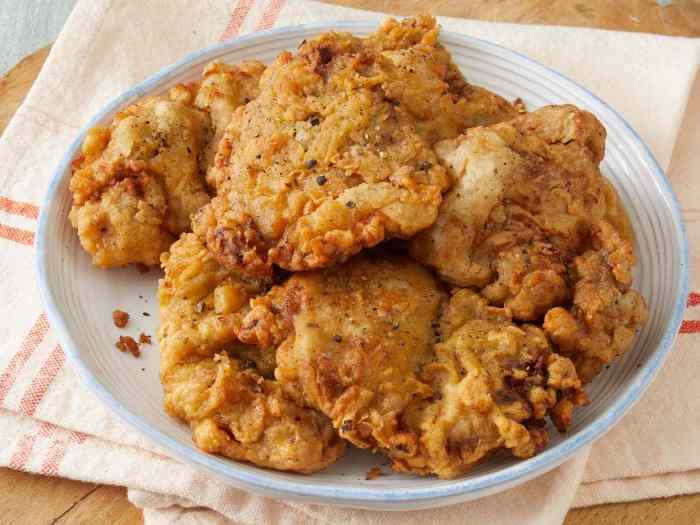
While the classic venison backstrap recipe offers a delightful taste, there are many ways to explore different flavors and textures, even experimenting with alternative protein sources.
Venison Backstrap Recipe Variations
Here are a few variations on classic venison backstrap recipes, incorporating different ingredients and techniques:
- Marinades:Enhance the flavor of venison backstrap by marinating it in a flavorful blend of ingredients like soy sauce, garlic, ginger, honey, or citrus juice. Experiment with different marinades to find your favorite combination.
- Glazes:Create a beautiful and flavorful finish by glazing the venison backstrap with a sweet and savory glaze. Options include honey-mustard glaze, balsamic glaze, or a simple maple syrup glaze.
- Seasonings:Explore various seasonings beyond the typical salt and pepper. Experiment with herbs like rosemary, thyme, or sage, or spices like paprika, cumin, or chili powder.
- Cooking Techniques:Instead of pan-searing, try grilling, roasting, or even smoking the venison backstrap for a different flavor profile and texture.
Substituting Venison Backstrap
Venison backstrap can be substituted with other cuts of meat or alternative protein sources, but adjustments to cooking times and temperatures may be necessary.
- Beef Tenderloin:Beef tenderloin is a popular substitute for venison backstrap, offering a similar tenderness and flavor. Cooking times will need to be adjusted based on the thickness of the cut.
- Pork Tenderloin:Pork tenderloin is another good option, providing a slightly milder flavor. Cook it to an internal temperature of 145°F (63°C) for safe consumption.
- Chicken Breast:Chicken breast can be used as a substitute, but it will cook much faster than venison backstrap. Reduce the cooking time accordingly.
- Salmon:For a different flavor profile, consider using salmon as a substitute. Cook it to an internal temperature of 145°F (63°C) for medium-rare.
Adjusting Cooking Times and Temperatures
When substituting venison backstrap with other meat types, it’s crucial to adjust cooking times and temperatures to ensure proper doneness.
- Beef:Beef tenderloin should be cooked to an internal temperature of 130°F (54°C) for medium-rare, 140°F (60°C) for medium, and 150°F (65°C) for medium-well.
- Pork:Pork tenderloin should be cooked to an internal temperature of 145°F (63°C) for safe consumption.
- Chicken:Chicken breast should be cooked to an internal temperature of 165°F (74°C) for safe consumption.
- Salmon:Salmon should be cooked to an internal temperature of 145°F (63°C) for medium-rare.
Important Note:Always use a meat thermometer to ensure the meat is cooked to the desired doneness. Overcooked venison backstrap can become tough and dry, while undercooked meat can pose a food safety risk.
Serving and Presentation
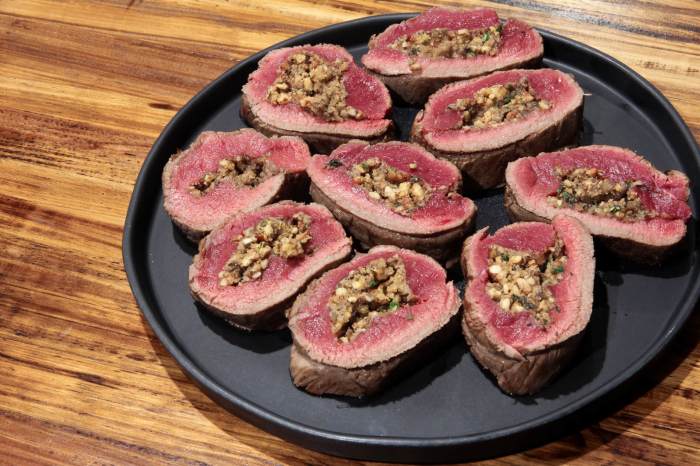
Presenting venison backstrap is an art form that elevates the dining experience. With a little creativity, you can transform a simple dish into a culinary masterpiece.
Finish your research with information from boneless wings recipe.
Carving and Slicing Venison Backstrap
The way you carve and slice venison backstrap significantly impacts its visual appeal. It’s important to cut the meat across the grain, which helps to tenderize it and enhances the flavor.
- For a classic presentation, slice the venison backstrap into medallions, approximately 1/2 inch thick. These medallions can be arranged in a circular pattern on a serving platter, creating a visually appealing centerpiece.
- If you prefer a more rustic look, consider slicing the venison backstrap into thick strips, which can be arranged on a wooden board with accompaniments.
- For a modern presentation, consider using a sharp knife to carve the venison backstrap into thin slices, which can be fanned out on a plate and drizzled with a flavorful sauce.
Garnishes and Accompaniments
Garnishes and accompaniments can elevate the visual appeal of venison backstrap and enhance its flavor profile.
- Fresh herbs, such as rosemary, thyme, or parsley, add a touch of color and fragrance.
- Citrus zest, such as lemon or orange, adds a bright and refreshing flavor.
- A drizzle of balsamic glaze or a reduction of red wine sauce adds a touch of sweetness and acidity.
- Roasted vegetables, such as asparagus, Brussels sprouts, or butternut squash, complement the savory flavors of venison backstrap.
- A side of creamy polenta or mashed potatoes adds a comforting element to the dish.
Creative Presentation Ideas
Here are a few creative ideas for presenting venison backstrap:
- Serve the venison backstrap on a bed of arugula, with a drizzle of balsamic glaze and shaved Parmesan cheese.
- Arrange the venison backstrap on a bed of roasted root vegetables, such as carrots, parsnips, and potatoes.
- Serve the venison backstrap with a side of wild rice pilaf and a cranberry sauce.
- For a more modern presentation, consider serving the venison backstrap on a bed of quinoa with a drizzle of chimichurri sauce.
Storage and Leftovers
Properly storing and utilizing leftover venison backstrap can ensure you enjoy its flavor and texture for longer. This section will cover methods for storing cooked venison backstrap, ideas for using leftovers, and techniques for freezing it for future use.
Storing Cooked Venison Backstrap
Storing cooked venison backstrap correctly is crucial for maintaining its quality and preventing spoilage.
- Refrigerate cooked venison backstrap within two hours of cooking, ideally within one hour, especially in warmer temperatures. Refrigerate in an airtight container or wrap tightly with plastic wrap to prevent drying out and absorbing other flavors in the refrigerator.
- Cooked venison backstrap can be safely stored in the refrigerator for up to 3-4 days. After this period, the quality and flavor may start to decline.
Using Leftover Venison Backstrap
Leftover venison backstrap can be repurposed into delicious and satisfying meals. Here are some ideas:
- Salads:Slice or dice leftover venison backstrap and add it to salads for a protein boost and a unique flavor. Consider pairing it with greens, vegetables like bell peppers, onions, or cucumbers, and a vinaigrette dressing.
- Sandwiches:Thinly slice leftover venison backstrap and use it as a filling for sandwiches. Try combining it with cheese, lettuce, tomato, and your favorite bread.
- Pasta:Dice or shred leftover venison backstrap and incorporate it into pasta dishes. Pair it with your favorite pasta sauce, vegetables, and cheese for a hearty and flavorful meal.
- Soup:Add diced leftover venison backstrap to soups or stews for added protein and flavor.
Freezing Venison Backstrap
Freezing venison backstrap allows you to enjoy it later.
- Wrap the venison backstrap tightly in plastic wrap or aluminum foil, ensuring no air pockets are present.
- Place the wrapped venison backstrap in a freezer-safe bag, squeezing out excess air before sealing the bag.
- Label the bag with the date and contents for easy identification.
- Freeze venison backstrap for up to 3-4 months for optimal quality.
- When ready to use, thaw frozen venison backstrap in the refrigerator overnight.
Final Review
With its versatility and inherent deliciousness, venison backstrap is a culinary treasure waiting to be discovered. By following the tips and techniques Artikeld in this guide, you can elevate your cooking skills and impress your guests with mouthwatering venison backstrap creations.
From classic preparations to innovative twists, the possibilities are endless, making venison backstrap a truly rewarding culinary experience.
